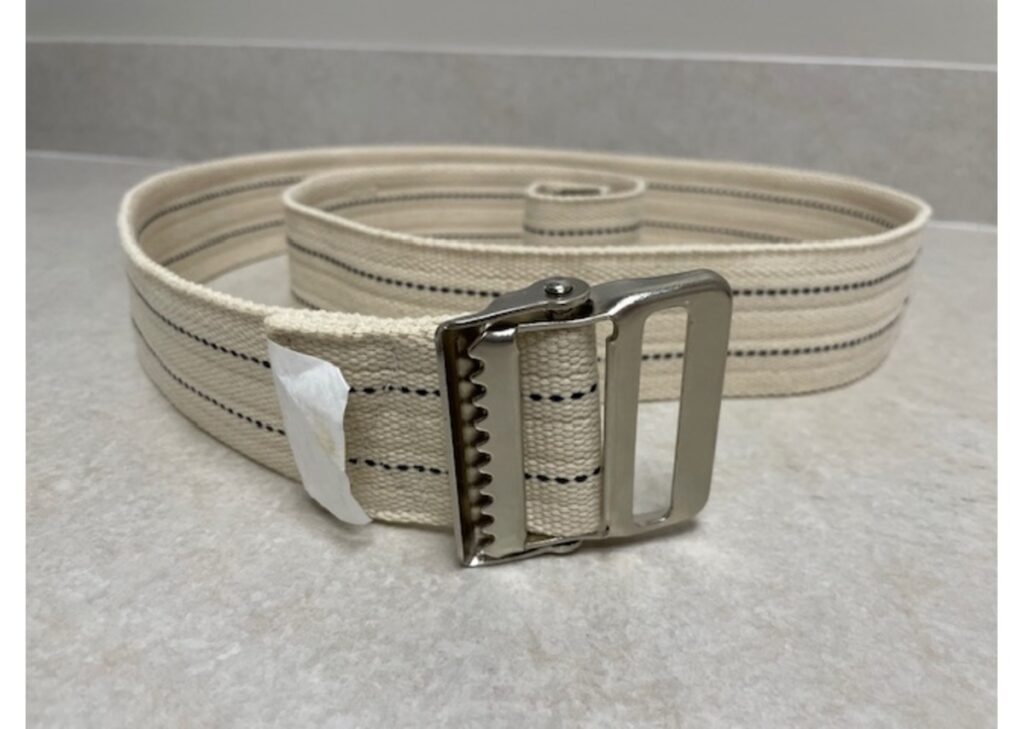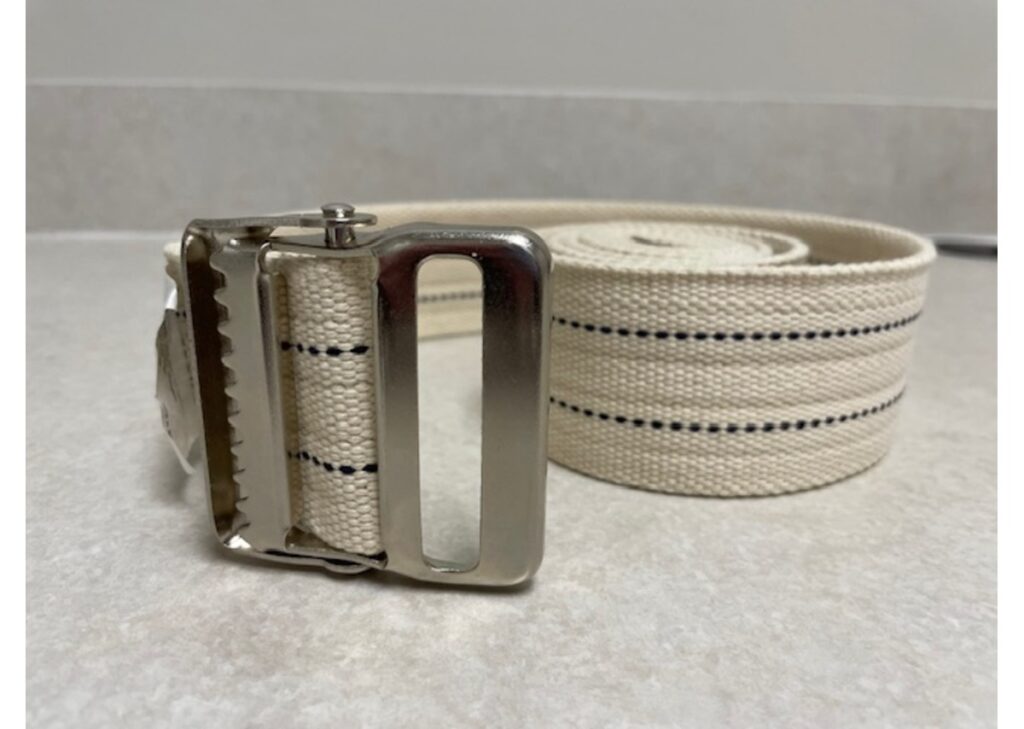Navigating the intricacies of patient mobility is a significant aspect of occupational therapy. At the forefront of ensuring safe and efficient movement is the gait belt, an indispensable tool in the arsenal of healthcare professionals. Whether you’re a seasoned occupational therapist or new to the field, understanding the myriad benefits and correct usage of a gait belt can enhance your practice and ensure patient safety.
What is a Gait Belt?

A gait belt is a simple yet effective device designed to assist caregivers in supporting individuals with mobility challenges. Typically made from durable fabric, a gait belt features a secure buckle to wrap snugly around a patient’s waist. This tool acts as a supportive handle for caregivers, allowing them to help patients stand, walk, or transfer safely.
Understanding the purpose and design of a gait belt is essential. These belts often come equipped with handles or loops, providing additional grip points for caregivers. This design not only facilitates safer handling but also aids in guiding patients as they move, minimizing the risk of falls.
Gait belts are versatile tools used across healthcare settings, from hospitals to home care environments. Their primary function is to promote safe and efficient movement, reducing the risk of injuries for both caregivers and patients.
Gait Belt Uses and Benefits
The uses of gait belts extend far beyond basic support. They are integral in various scenarios, including:
- Patient Handling: Gait belts offer a reliable means of supporting patients during transfers from sitting to standing positions, aiding in balance and coordination.
- Mobility Assistance: They provide caregivers with a secure grip to guide patients during walking exercises, ensuring stability and confidence.
- Fall Prevention: Proper use of a gait belt significantly reduces the likelihood of falls, protecting both patients and caregivers from potential harm.
The safety of both the caregiver and the patient is paramount. When used correctly, a gait belt enhances safety by offering a controlled grip that minimizes the risk of sudden movements or slips. This device is crucial for maintaining dignity and reducing anxiety in patients who require assistance.
How to Use a Gait Belt Correctly
Employing a gait belt correctly is crucial for maximizing its benefits. Here’s a step-by-step guide on how to use it effectively in different scenarios:
1. Positioning the Belt:
- Place the gait belt around the patient’s waist, ensuring it sits snugly yet comfortably.
- Fasten the buckle securely, leaving enough room for two fingers to fit between the belt and the patient.
2. Assisting with Standing:
- Stand close to the patient, grasping the belt for stability.
- Encourage the patient to use their arms to push off and assist their rise.
- Grasp your hands on the gait belt to assist with lifting the patient into a standing position.
3. Guiding During Walking:
- Position yourself slightly behind and to the side of the patient.
- Use the gait belt handles to guide their movement, offering support and direction.
4. Transferring Patients:
- Align the gait belt with the patient’s center of gravity.
- Assist them in shifting weight as needed, using the belt to maintain balance and control.
Patient comfort is a priority. Always ensure the gait belt is positioned correctly to prevent discomfort or skin irritation. Communicate with the patient throughout the process to ensure they feel secure and informed.
Gait Belt Handling Techniques
Mastering proper handling techniques is key to using a gait belt effectively. Here are some tips to ensure optimal use:

Use Proper Lifting Techniques:
- Bend your knees and keep your back straight while using the belt.
- Avoid sudden jerks or pulls, maintaining a steady grip for controlled movements.
Avoid Common Mistakes:
- Ensure the belt is not too tight, which can cause discomfort.
- Do not use the belt as a restraint; it should only aid in movement.
- Make sure to take off the belt once the patient is in a safe position.
Practice makes perfect. Familiarize yourself with different scenarios to build confidence in handling various patient needs. Regular practice enhances your ability to respond effectively in real-time situations.
Gait Belt for the Older Adult
When working with elderly patients, specific considerations are essential to ensure safety and comfort:
- Secure Positioning:
- Place the gait belt gently around their waist, avoiding any pressure on sensitive areas.
- Ensure the belt is fastened securely but comfortably.
- Provide Gentle Guidance:
- Use the belt to offer subtle support, allowing the patient to initiate movement.
- Maintain a close presence to provide reassurance and prevent falls.
- Address Challenges:
- Be mindful of any health conditions that may affect mobility.
- Adjust the level of support based on the patient’s strength and coordination.
Gait belts offer significant benefits in older adult care. They empower patients to move independently while ensuring safety and reducing the risk of falls. Patience and empathy are vital when assisting elderly patients, fostering a supportive environment that enhances their confidence.
Importance of Training in Gait Belt Use
Proper training is paramount for caregivers to utilize gait belts effectively. Here’s why adequate training is essential:
- Ensuring Safe Usage:
- Training equips caregivers with the knowledge to use gait belts correctly, reducing the risk of injury.
- Caregivers learn to assess individual patient needs and adapt techniques accordingly.
- Building Confidence:
- Comprehensive training instills confidence in caregivers, enabling them to respond effectively in various scenarios.
- A well-trained caregiver can reassure patients and improve their overall experience.
- Accessing Resources:
- Seek out training programs or workshops that provide hands-on experience.
- Explore online resources and video tutorials for additional guidance.
Continuous learning is encouraged. Staying updated on best practices enhances your ability to provide exceptional care and support to patients.
Frequently Asked Questions
What is a gait belt?
A gait belt is a device used to assist caregivers in helping individuals who may have difficulty walking or standing. It is typically made of durable fabric and features a buckle to secure it around the waist.
Gait belt definition
A gait belt is a device used to assist caregivers in supporting individuals with mobility challenges. It is an essential tool for promoting safe and efficient movement, reducing the risk of falls and injuries for both caregivers and those they are assisting. Gait belts come in various sizes and styles, but all serve the same purpose of providing support during mobility tasks. They are commonly used in healthcare settings but can also be useful in home care situations. Proper usage techniques should always be followed to ensure safety for both the caregiver and the individual being assisted.
Do gait belts have handles?
Yes, many gait belts come with handles or loops, which provide additional grip points for caregivers, making it easier to assist individuals safely. These handles can also be used to help guide someone’s movements while walking.
How to use a gait belt?
To use a gait belt, place it around the individual’s waist, ensuring it is snug yet comfortable. The caregiver can then grasp the belt when assisting the person in standing, walking, or transferring.
How to use a gait belt for older adults?
When using a gait belt for an older adult, it is essential to follow proper safety precautions. Make sure the belt is securely fastened and that the caregiver has a good grip on the handles or fabric. Additionally, take care not to pull on the belt too tightly, as this may cause discomfort or injury.
Conclusion
Gait belts are invaluable tools in the realm of occupational therapy, offering stability and support to those who need it most. Their versatility makes them essential for healthcare professionals dedicated to promoting safe and efficient patient mobility.
By understanding the nuances of using gait belts, you can enhance your caregiving skills and ensure the well-being of your patients. Remember, proper training and practice are fundamental to mastering these techniques.
For further insights and resources on gait belt uses, consider exploring additional training programs or consulting with experienced professionals. Your commitment to learning will undoubtedly lead to improved outcomes for both caregivers and patients alike.
The information provided on this website is for general informational purposes only. It is not intended as, nor should it be considered, professional or medical advice. Always consult a professional regarding your specific medical issue.
Additional FAQs
How to use a gait belt to lift someone from the floor?
In emergency situations where someone has fallen and needs assistance getting up, a gait belt can be useful in helping caregivers lift them safely from the floor. To do so, carefully slide the gait belt securely around their waist, then use proper lifting techniques.
How to use a gait belt for the elderly?
When using a gait belt for the elderly, ensure that it is properly positioned around their waist. The caregiver should remain close and provide support while guiding the individual, allowing for smoother movement and reducing the risk of falls.
References
- Hoyer, E. H. (2016). Safe Patient Handling and Movement: A Guide for Healthcare Providers. American Nurses Association.
- Henneman, E. A., & Gittelman, M. A. (2018). “Enhancing Patient Safety Through Proper Transfer Techniques.” Journal of Nursing Care Quality, 33(4), 331-338.
- McCleskey, J., & Fletcher, D. (2021). “The Role of Gait Belts in Reducing Fall Risks Among Elderly Patients.” Geriatric Nursing, 42(5), 123-128.
- McCauley, K., & Brown, K. (2019). Patient Mobility: Strategies for Safe Transfers and Ambulations. Elsevier.
- Occupational Safety and Health Administration (OSHA). (2020). “Guidelines for Preventing Workplace Injuries: Ergonomics for the Healthcare Industry.” Available at: [osha.gov](https://www.osha.gov).
Recently Featured OT Insider Posts
SBA (Stand-by Assist) in Occupational Therapy for Patient Care
Understanding the HOB Medical Abbreviation in Patient Care
Navigating Multiple Sclerosis (MS) with Occupational Therapy
CABG Care for OT Professionals
Sternal Precautions for Cardiac Patients Post-CABG in OT
Spinal Precautions: Essential Guidelines for Occupational Therapy
Transforming Lives with the PEO Model in Occupational Therap
